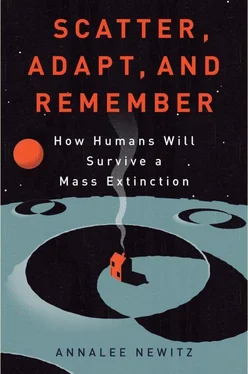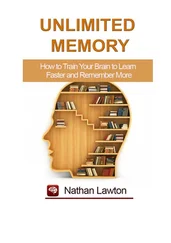To make Earth habitable for another million years, we will have to start taking responsibility for our climate in the same way we now take responsibility for hundreds of thousands of acres of farmland. Geoengineering of some kind is critical for our survival, because it’s inevitable that our climate will change over time. Certainly we’ll have to adapt to new climates, but we’ll also want to adapt the climate to serve us and the creatures who share the world’s ecosystems with us. If we want our species to be around for another million years, we have no choice. We must take control of the Earth. We must do it in the most responsible and cautious way possible, but we cannot shy away from the task if we are to survive.
Of course, we can’t stop at the edges of our atmosphere. If climate change doesn’t extinguish us, an incoming asteroid or comet could. That’s why we’re going to have to control the volume of space around our planet, too. We’ll find out how that would work in the next chapter.
20. NOT IN OUR PLANETARY BACKYARD
WE ALREADY KNOW what an asteroid strike did to the creatures who lived during the Cretaceous period. Though it may not have been the sole driver of the K-T mass extinction, the 6.2-mile-diameter bolide that landed off the coast of Mexico roughly 65 million years ago devastated the planet, radically altering the Earth’s climate for possibly a decade or more. Among the scientists who study impacts, that one would have been classed as a 10 out of 10 on the Torino scale, a kind of Richter scale used to quantify impact hazards. Such disasters, where the entire planet is affected, are likely to strike once every 100,000 years or so (though not necessarily with the destructiveness of the K-T impact). That means we are long overdue for another one.
Will we wake up tomorrow to a newscaster telling us that humanity has six months to live, so we’d better make the best of things before an asteroid wipes us out?
Not likely. Contrary to Hollywood myths, we’d probably see an asteroid like the one that hit during the K-T mass extinction coming many years before it smashed into us. Less than two decades after scientists discovered the role an asteroid played in the planet’s most recent mass extinction, NASA launched an asteroid-spotting program called Spaceguard. The goal of Spaceguard was to discover and track 90 percent of near-Earth objects larger than a kilometer. A near-Earth object, or NEO, refers to asteroids, meteoroids, comets, and other heavenly bodies whose orbits around the sun bring them close to our own orbit. Most NEOs are not dangerous—they’re either so small that our atmosphere would burn them up, or they zip past us millions of kilometers away. That being said, there is a class of NEO called potentially hazardous objects, or PHOs, and these are the ones we have to be worried about. To achieve PHO status, an object has to be larger than 1 km and its likely trajectory must take it closer than 7,402,982.4 km from Earth.
That sounds pretty far away, especially when you consider that we’ve had some near misses over the past two decades when sizable asteroids have come within thousands of kilometers of the planet (some would have caused explosions comparable to a nuclear bomb if they had hit). But our solar system is a constantly shifting set of gravitational fields, and the orbits of small objects shift a lot over time. If an asteroid zooms past Jupiter or another planet on its way to us, gravity from that other body could easily pull the asteroid into a new course, converting it from distant to deadly. That’s why astronomers want to keep a sharp eye on any large rocks or balls of ice that come within a few million kilometers of our orbit.
The good news is that over the past two decades, we’ve gotten pretty good at spotting and tracking NEOs and PHOs. The bad news is that, at least right now, nobody is quite sure what we’d do in what NASA astronomer and asteroid hunter Amy Mainzer calls one of the most hopeful scenarios. That would be when an astronomer—possibly Mainzer herself—verifies tomorrow that there’s a mile-diameter asteroid twenty years out, on a direct collision course with Earth.
Preparing for an Asteroid Hit
Mainzer is obsessed with seeing into space. That’s why she’s worked on instrumentation for NASA spacecraft like the WISE (Wide-field Infrared Survey Explorer) satellite, whose sole job was to map as much of the sky as possible using an infrared telescope. Once the WISE mission was complete, Mainzer and her colleagues were able to reprogram the craft in 2010 to scan the sky for NEOs—they dubbed this mission NEOWISE. It was the NEOWISE mission that helped complete the Spaceguard project by identifying enough one-kilometer-or-bigger NEOs that we can say with confidence that we now know where 90 percent of them are. In all, we’ve located nearly 900 NEOs of that size. “That’s good for Earthlings,” Mainzer told me lightly by phone from her office at the Jet Propulsion Lab in California. But then, more seriously, she added, “We don’t know where most of the other ones are.” In her most recent work, Mainzer gathered data on PHOs among asteroids, and she and her colleagues estimate there might be as many as 4,700 of these potential impactors that are bigger than 100 meters. To give you a sense of what that means, a 100-meter asteroid wouldn’t cause a mass extinction, but it would easily flatten a city or a small country. If it landed in the ocean, the tsunamis it generated could do profound damage to coastal areas.
Given that our local volume of space is swarming with deadly rocks, why aren’t we bombarded all the time? The simple answer is that we are. Every day, we are hit by tiny NEOs, most of which we never notice because they flame out before reaching the Earth’s surface. “You know the video game Asteroids?” Mainzer asks. Of course I do. “Well, it’s actually pretty accurate. Asteroids break up and make more little pieces. And there are far more little pieces than big pieces.” Aside from the relative rarity of larger asteroids, there’s also the fact that our solar system is a dynamic, constantly shifting sea of debris. All the overlapping gravitational fields of the planets and their moons may send rocks spinning into our path, but they also send them spinning out of it, too. “If you put a particle in near-Earth space, it doesn’t stay stable,” Mainzer explained. “After about ten million years, it will go into the outer solar system, crash into the sun, or crash into the Earth.” Keep in mind that 10 million years is nothing to a planet like Earth, which has been around for 4.5 billion years. Essentially, there’s only a short time window for these NEOs to do any damage before they’re hurled elsewhere by gravity.
Still, Mainzer notes, there are probably “source regions” of the asteroid belt that are constantly resupplying the inner system with new NEOs. Possibly these source regions are shooting out new NEOs because of gravitational resonances with Mars and Jupiter, the two planets whose orbits sandwich the asteroid belt. “I like to think of it as a flipper on a pinball machine,” Mainzer said. “That’s what these resonances are like in the main belt—if an asteroid drops into one, it can get hurled very far from its original location.”
With the amount of data we’ve gathered from satellites like NEOWISE, it’s reasonable to hope we’d have twenty years to deal with an asteroid or other PHO big enough to cause destruction over the entire Earth. Knowing where most of the large NEOs are can help astronomers to track their movements and determine whether they’re on a collision course. That said, collision courses are always expressed in probabilities. We can’t predict precisely where gravity will tug one of these objects on its way to our cosmic neighborhood. Also, we’re still struggling to track objects that could cause tremendous damage without actually destroying humanity. “Your warning time depends on the design of your instruments,” Mainzer said. She’s currently working on plans for a new space telescope, dubbed NEOCam, designed to spot objects smaller than 100 meters and to find more of those PHOs. “We’re designing it to give us decades of warning,” she said. The goal for Mainzer and others in her field is to get 20 to 30 years of warning for a likely impact, so that we have as many options as possible for stopping it.
Читать дальше






![Аннали Ньюиц - Автономность [litres]](/books/424681/annali-nyuic-avtonomnost-litres-thumb.webp)





